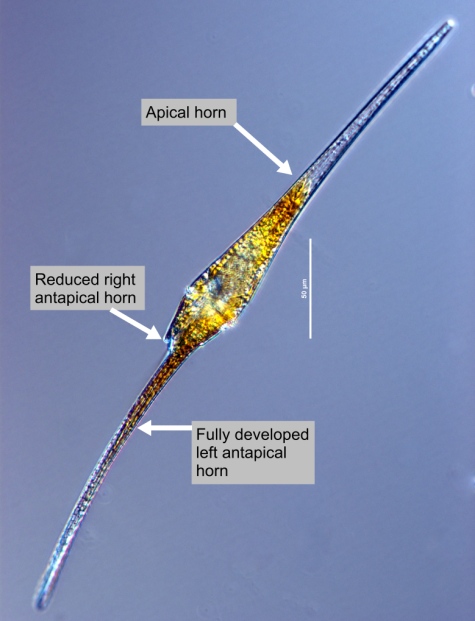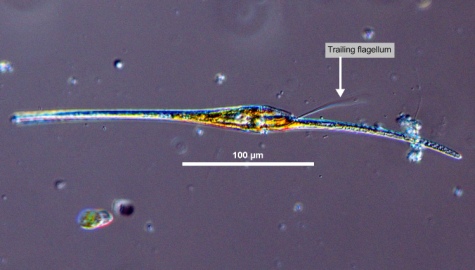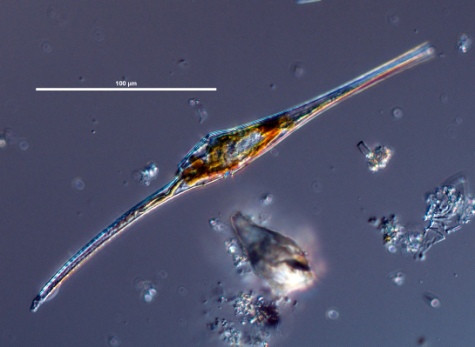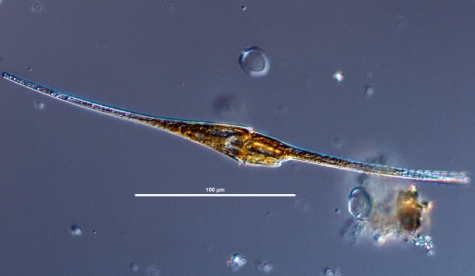



|
Synonym(s)
(EOL 2012)
Classification
(Guiry and Guiry 2012)
Lifestyle
Description
Fusiform
Torpedo-shaped. Shaped like a small boat when viewed from above.
fusiform. Cell CloseEpitheca
In thecate dinoflagellates, the anterior part of a dinokont cell above the cingulum. The equivalent of epicone for naked dinoflagellates.
epitheca ends in a long straight CloseApical
(axis, spine) The region of the apex or point. Refers to the most anterior point or region of the cell (HPP 2003).
apical CloseHorns
The apical or antapical extensions found in some armoured dinoflagellates; they contain cytoplasm, are covered in thecal plates and can be hollow or partially solid (Horner 2002).
horn while the CloseHypotheca
In thecate dinoflagellates, the posterior part of a dinokont cell above the cingulum. The equivalent of a hypocone for naked dinoflagellates.
hypotheca ends in a fully developed left CloseAntapical
Referring to the most posterior point of a cell. The opposite of apical.
antapical horn and a reduced right antapical horn (Montagnes 2006). The right antapical horn is so reduced that it looks like a bump, often giving the cell a gentle curve.Measurements
Width: 15 - 30 μm
Similar species
Harmful effects
Habitat
Distribution
This species is Close
Cosmopolitan
Widely distributed; occurring in many parts in the world.
cosmopolitan in cold temperate to tropical waters (Horner 2002). It is widely observed in sheltered waters in South China Sea and the coast of Hong Kong (Red-Tide 2012).Blooms in late summer to autumn (EOL 2012).
Growth conditions
Environmental Ranges
Temperature range (°C): -1.743 - 28.751
Nitrate (μmol L-1): 0.142 - 28.280
Salinity: 25.879 - 34
Oxygen (mL L-1): 0.935 - 8.617
Phosphate (μmol L-1): 0.051 - 2.337
Close
Silicic acid
A general term to describe chemical compounds containing silicon, oxygen and hydrogen with a general formula of [SiOx(OH)4-2x]n. Diatoms polymerize silicic acid into biogenic silica to form their frustules (Azam and Chisholm 1976).
Silicate (μmol L-1): 0.648 - 59.039Bloom characteristics
Pycnocline
(pycno- dense; -cline gradient) The depth in the water column at which the density changes rapidly. This density gradient can be caused by temperature (thermocline), salinity (halocline) or both. Because of the difference in density, bodies of water will often stay as distinct layers and not mix.
pycnoclines in CloseStratification
The development of distinct non-mixing layers in the water column resulting from a steep gradient in density, which is caused by differences in temperature and/or salinity.
stratified CloseWater column
Referring to a water system from the surface to the bottom sediments. This can be used to understand processes of stratification, mixing and their relationship to nutrient transport. Temperature, salinity, pH, and nutrient levels often vary along the length of the water column.
water columns (Baek et al. 2007). Blooms are initiated when surface water salinity drops after heavy rainfall, which creates strong pycnocline near the surface of the water (Baek et al. 2007).References
Baek, S. H., Shimode, S. and Kikuchi, T. 2007. Reproductive Ecology of the Dominant Dinoflagellate, Ceratium fusus, in Coastal Area of Sagami Bay, Japan. Journal of Oceanography. 63: 35-45.
Encylopedia of Life (EOL) 2012. Ceratium fusus (Ehrenberg) Dujardin 1841. http://eol.org/pages/899358/overview. Accessed 17 Jan 2012.
Horner, R. A. 2002. A Taxonomic Guide To Some Common Phytoplankton. Biopress Limited, Dorset Press, Dorchester, UK. 200.
Guiry, M. D. and Guiry, G. M. 2012. Ceratium fusus (Ehrenberg) Dujardin 1841. http://www.algaebase.org/search/species/detail/?species_id=54755. Accessed 17 Jan 2012.
Montagnes, D. 2006. Guide to Harmful Phytoplankton. University of Liverpool, UK. http://www.liv.ac.uk/hab/Data%20sheets/c_fusu.htm. Accessed 17 Jan 2012.
Scott, F. and Brandt, S. 2011. Ceratium fusus (Ehrenberg) Dujardin 1841. http://www.marinespecies.org/aphia.php?p=taxdetails&id=109951. Accessed 17 Jan 2012.
Red-Tide. 2012. Ceratium fusus (Ehrenberg) Dujardin 1841. http://www.red-tide.org/new_site/cfus.htm. Accessed 17 Jan 2012.
